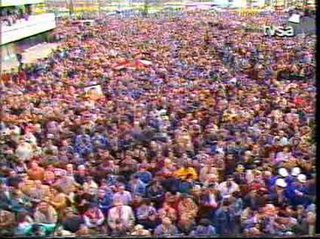 W
WThe breakup of Yugoslavia occurred as a result of a series of political upheavals and conflicts during the early 1990s. After a period of political and economic crisis in the 1980s, constituent republics of the Socialist Federal Republic of Yugoslavia split apart, but the unresolved issues caused bitter inter-ethnic Yugoslav wars. The wars primarily affected Bosnia and Herzegovina, neighbouring parts of Croatia and, some years later, Kosovo.
 W
WThe 1991 riot in Zadar was an act of violence that took place in the Croatian city of Zadar on 2 May 1991. Following an incident in the Zadar hinterland in which a Croatian policeman was killed, reportedly by SAO Krajina militiamen, Croatian civilians vandalized, destroyed and looted properties belonging to ethnic Serbs and Yugoslav companies in the city.
 W
WThe 1991 protest in Split was a street protest against the Yugoslav People's Army held in Split, Croatia on 6 May 1991. The protest was organised by the Croatian Trade Union Association in the Brodosplit Shipyard and joined in by workers from other companies in the city and other residents of Split after radio broadcast appeals for help while the protesters marched through the streets. Ultimately, the protest drew 100,000 supporters.
 W
WFollowing the rise of nationalism and political tensions, as well as the outbreaks of the Yugoslav Wars, numerous anti-war movements developed in Serbia. The 1991 mass protests against Slobodan Milošević regime which have continued throughout the wars reinforced young people's antiwar orientation. The demonstrations in Belgrade were held mostly because of opposition the Battle of Vukovar, Siege of Dubrovnik and Siege of Sarajevo, while protesters demanded the referendum on a declaration of war and disruption of military conscription.
 W
WOn 5 April 1992, in response to events all over Bosnia and Herzegovina 100,000 people of all nationalities turned out for a peace rally in Sarajevo. Serb snipers in the iconic Holiday Inn hotel under the control of the Serbian Democratic Party in the heart of Sarajevo opened fire on the crowd killing six people and wounding several more. Suada Dilberović and an ethnic Croat woman Olga Sučić were in the first rows, protesting on the Vrbanja bridge at the time. The bridge on which Sučić and Dilberović were killed was renamed in their honor. Six Serb snipers were arrested, but were exchanged when the Serbs threatened to kill the commandant of the Bosnian police academy who was captured the previous day, after the Serbs took over the academy and arrested him.
 W
WThe Gazimestan speech was given on 28 June 1989 by Slobodan Milošević, then president of Serbia, at the Gazimestan monument on the Kosovo field. It was the centrepiece of a day-long event to mark the 600th anniversary of the Battle of Kosovo, which was fought at the site in 1389.
 W
WBetween 1992 and 1994, the Federal Republic of Yugoslavia (FRY) experienced the third-longest period of hyperinflation in world economic history. This period spanned 22 months, from March 1992 to January 1994. Inflation peaked at a monthly rate of 313 million percent in January 1994. Daily inflation was 62%, with an inflation rate of 2.03% in 1 hour being higher than the annual inflation rate of many developed countries. The inflation rate in January 1994, converted to annual levels, reached 116,545,906,563,330 percent (116.546 billion percent, or 1.16 × 1015 percent). During this period of hyperinflation in FR Yugoslavia, store prices were stated in conditional units – point, which was equal to the German mark. The conversion was made either in German marks or in dinars at the current "black market" exchange rate that often changed several times per day.